Starting a busy day with a detailed plan is an excellent way to get everything done. However, even a comprehensive timetable can be hard to follow if you become easily distracted and keep procrastinating.
If you find yourself in this situation and struggle to get things done every day, don’t worry, you are not alone.
However, if you don’t do anything to get yourself out of these situations and are always falling behind at work, you will keep digging yourself a deeper hole – one that you won’t be able to get out of easily.
Moreover, being unproductive at work can impact both your short- and long-term career goals.
Techniques for Increasing Productivity
Fortunately, there are many productivity methods that can help you overcome your habits that lead to inefficiency and get more things done during the day.
Listed below are the five best productivity-boosting methods backed by science:
#1. Brain Training
Neuro feedback is a non-invasive, medication-free, reward-based training system for the brain. It is a form of biofeedback that works to change the electrical activity of your brain and help it self-regulate.
Neuro feedback brain training sessions are done in a specially designed and controlled clinic. Non-invasive EEG sensors are connected to your scalp while you relax in a comfy chair. You will then be asked to watch a video, movie, or television show of your choice or listen to tunes that you like.
The stimulus will act as a mode to provide you with the feedback of your own brain wave activity.
Whenever your brain completes the right brain activity, you will be rewarded with a bigger screen size and clearer video or audio.
Brain training can help increase your productivity through the following ways:
- Improving your attention, concentration, and working memory
- Enhancing multitasking skills without compromising work quality.
- Increasing creativity and mental agility
- Boosting intrinsic motivation consistency
- Improving skill acquisition
To experience these benefits, you have to work with an expert trained in neurofeedback. Moreover, follow your specialist’s recommendation regarding the number of sessions you have to complete.
#2. SMART Goals Method
Writing SMART or specific, measurable, achievable, relevant, and time-bound goals every week or month can help you become more productive on a daily basis.
When you set a goal based on the five factors, you make them measurable and more realistic and doable. Additionally, you have a clearer picture of what needs to be accomplished and when and how you can work on them.
The SMART goals method helps you reduce generalities and guesswork and at the same time, set clear timelines. This will make it easier for you to track your progress and pinpoint milestones you may have missed.
Writing things down on paper or in a planner adds another layer of strengthening the neural pathway in your brain. This makes it easier for your brain to follow through with your goals.
To use this technique to boost daily productivity, follow these tips:
- Jot down your SMART goals on a piece of paper and pin it somewhere you can always see them. You can also write them on a whiteboard if you have one. This list will serve as a reminder of what you are working hard for every day.
- Check your progress regularly. If you completed the initial steps, highlight or put a check-mark beside them. Doing this every day allows you to know if you are on the right track or have to step up your game.
- Acknowledge your wins. Give yourself a pat on the back whenever you complete a step or achieve a minor goal.
#3. Personal Kanban
Personal Kanban is a simple technique that helps boost productivity. This method emphasizes two vital rules: visualize your work and limit the work in progress.
Visualizing your work is the first important element of the Personal Kanban method. Visual cues allow you to identify quickly what you should prioritize and work on next. They also remind you of the time you need to complete them.
The next element, which is limiting your work in progress, is just as vital as the first one. This concept emphasizes the need to minimize the number of things you have to work on at a given time.
The Personal Kanban method requires simple materials: a board, post-it notes, and pen or marker.
Divide the board into three columns: Doing, To-Do and Backlog, and Done.
Write each task on a Post-It note. Put the ones you have to work on right now or need to do immediately under the Doing section.
Put the tasks you have not completed yet or are not working on now but have to do next on the To-Do and Backlog section.
Once you are done with any task, move the note to the Done section.
When you organize your tasks by priority under the Doing and To-Do and Backlog sections, you will be able to do a lot during the day. The goal of moving several notes to the Done part can motivate you to stay productive as well.
#4. The Pomodoro Technique
If poor time management is causing you to be less productive, consider following the Pomodoro Technique.
The Pomodoro Technique was developed by Francesco Cirillo in the 1980s. It is a time management method that entails working in 25-minute intervals with regular breaks between these sprints.
This technique requires the use of a stopwatch or timer and these steps:
- Choose the task you have to complete.
- Set the timer to 25 minutes.
- Work on the task for 25 minutes straight.
- Stop working when the timer goes off and put a check-mark on a piece of paper or board.
- If you have fewer than four check-marks, take a three- to five-minute break and go back to step 2. If you have four or more, continue to step 6.
- Take a 15- to 30-minute break once you have completed your task. Next, choose another task, reset your check-mark count, and go back to the first step.
- You can use an app or even your smartphone as your timer. If you want to stay true to the technique, get a Pomodoro kitchen timer.
With the strict system and visual cues, you will have no difficulties being productive with this time management method.
#4. Zen to Done (ZTD) System
The ZTD system is a productivity method developed by Leo Babauta of Zen Habits. It helps improve your productivity by encouraging you to concentrate on forming only one habit at a time.
The ZTD system encourages people to form 10 habits to boost their productivity. However, the method has a simplified technique called Minimalist ZTD, which is also effective in increasing your efficiency and work performance.
These steps include:
- Collecting the tasks you have to do every week or month and writing them down on a list.
- Processing and reviewing your list daily and thinking about how to work on each item.
- Choosing high-priority items and accomplishing them every day and week.
- Schedule time to work on your high-priority items without interruptions.
When following this system, start focusing on the habit that appeals to you the most. Work on it for a month, then move on to the next habit.
With one month for each core habit, within four months, you will develop all the habits you need to stay on top of your to-do list and be productive.
Whether you can’t find the time to prepare for a presentation or speaking engagement or to write a new post for your blog because you have too many things to do every day, try one or more of these methods to be more productive.
AUTHOR BIO:
Dr. Upasana Gala is the founder and CEO of Evolve Brain Training, an award-winning neuro feedback-centered institute that focuses on using non-invasive brain training techniques to maximize the brain’s true potential. Earning a doctorate in Neuroscience from the revered Baylor College of Medicine, Dr. Gala has spent over a decade trying to unravel the way neuro chemical and neuro physiological changes in the brain affect the way we interact with the world. Her goal is to share her knowledge, encourage others to tap into and expand their brain’s capabilities, and dispel any myths surrounding our most complex organ.
















